The investigations show that the four thousand years ago the tribes lived in the territory of Azerbaijan made original kitchen implements, weapons and accessories of stone, clay and metal and used them in their life. Those works of art have for a long time attract the interest of art-researchers for their original form, exact construction and designs on them.
Among rich museum collections of Victoria and Albert in London, Luvr in Paris, Metropoliten in Washington, and museums of Vienna, Rome, Berlin, Istambul, Tehran, Cairo one may find the works of art created by hands of the masters of Tebriz, Nakhchivan, Ganja, Gazakh, Guba, Baki, Sheki, Shamakhi and Karabakh.
The appearance of our works of arts, considered the jewelry of the world museums, in the museums and personal collections of European, Asian, American countries lean on a great historical background. Many of them were bought from separate individuals, some were brought by foreign travelers, merchants, diplomats and scientists visited Azerbaijan, some were stolen.
Azerbaijan works of art in the museums of Moscow. Long scientific investigations revealed that a great part of works of art created by Azerbaijan people for centuries, is kept in Moscow as well as in other great cities of the world.
They are generally kept in the House o Weapons in Kremlin, in the museum of Eastern folks,in the State Historical Museum, in the museum of folk creativity, in the churches of Moscow and its suburbs( the mosques of Savvo-Storojevski, Sergiyevo, the monastery of Kiril-Belozyerski etc.)
The most figurative and original patterns of Azerbaijan art kept in Moscow are in the House of Weapons in Kremlin.
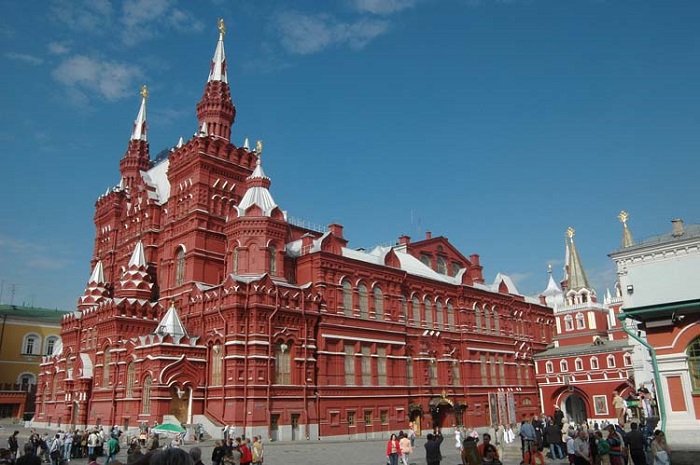
Original works of Azerbaijan art are also demonstrated together with art of Turkish, Iranian, Indian, French, English, Germanic people.
The majority of works of Art kept in House of Weapons is the works of jeweler`s art and metal art. We must specially mention hoods, shields, swords, daggers and accessories.
Among Azerbaijan jewelries exhibited in House of Weapons in Kremlin particular interest deserves a figurative shield of the XVI century.
Together wit the shield we must also speak of two more works of art made in Azerbaijan at that time. They are an armored head-dress used by the nobles in war and a couple of elbow-rest.
As in the case of figurative shield, there is no exact information about the time and the name of the one who brought it here.
When speaking of the decoration of metal works kept in the House of Weapons we must mention about written in Arabic alphabet words and sayings shown among the pictures and designs of the abovementioned. Those scripts generally reflect the time of their creation and the name of the customer, as well as words taken from Guran and also the parts of classical poems.
To their artistic peculiarities the cloths kept in the House of Weapons may be divided into ornamental cloth and topical cloths.
Topical clothes are more original and valuable. As on the cloths of this type we view different scenes taken from the works of East classics and those taken from Azerbaijan folk creation.
One of those cloths attract particular attention.
The works of Azerbaijan art kept in the Museums of Saint-Petersburg. Among museums preserving works of art created by masters of Azerbaijan museums located in Saint-Petersburg occupy an important position. The State Hermitage of Saint-Petersburg, Kazanski Sobor and other places are first among those museums.
In the department of culture of the East of the State Hermitage together with material culture of the people of Iran, Turkey, China, Japan and Arabia, one may find rare works of art of Azerbaijan people created during the centuries.
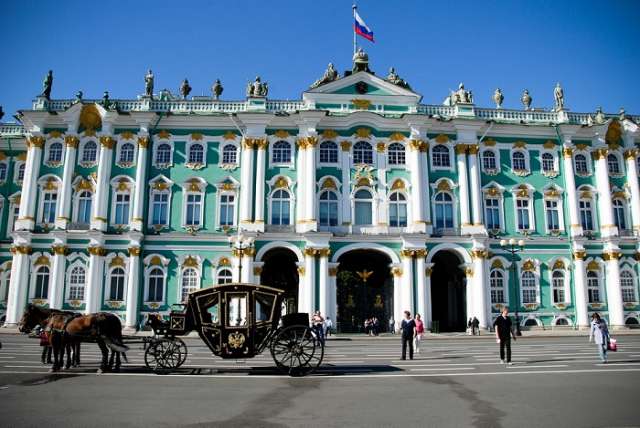
Here one may find engraved works of jewelry, pottery, stone, and wood and different works of weaving made by Azerbaijan masters since the ancient times up to the beginning of our century.
First of all the State Hermitage is a cultural center among the museums of the world preserving the ancient patterns of Azerbaijan mastership. Gathered here tender plates, swords, axes, waistbands and other accessories made of bronze create an interesting page of the art of the ancient period.
Among the monuments referred to II millennium b. c. exhibited at the Hermitage a bronze bull head found during archeological digs in Nagorny Karabakh attracts particular attention for its original form and exact composition.
At the State Hermitage among works of art referred to bronze age one may meet such kind of the accessories as waistbands, bracelets, colorful beads of different shape.
3000 year old patterns of jeweler`s art found during archeological digs once conducted in the village Khojaly of Karabakh are interesting for their original form and technical use. We should mention that some gold accessories kept at the State Hermitage today and referred to bronze age were found from here.
At State Hermitage of Saint-Petersburg we also have many samples of metal art referred to the middle ages.
According to their form and the theme those works of art might be grouped under two groups:
1. Monuments of plastic art
2. Everyday life equipments.
To plastic monuments kept here first of all belong bronze cast of bird, animal and human figures referred to the V-VIII.
A prominent scientist of Saint-Petersburg academician K.Trever,in terested in art and the history of the Caucasian Albania looks upon those figures as the continuation of the same type pottery found in Mingacheir. One of the mentioned figures has for a long time attracted the attention of the scientists. The figure referred to the VII century was found at the end of the XIX century in Nakhchivan. The figure is 35,6 high and according to the scientists it is the monument of Javanshir(638-670), the ruler of Caucasian Albania.
On the face of the square pedestal of the figure there is the description of two lions and a mountain goat. The sides are decorated with the scene of fight between the hunter and the lion and also ornamental motives of an elehant, a fox and plants.
Among plastic works of art made of metal Shirvan tube referred to 1206 is the most interesting exhibit.
Together with plastic works made of metal demonstrated at the State Hermitage of Saint-Petersburg one may find everyday decorated equipment original in form. To such samples of art we first of all refer bronze trays belonging to the VI-VIII centuries. Three of our trays kept at Hermitage are referred to the beginning of the middle ages. Two of them are decorated with topical descriptions, the third one has only ornaments on it. To the everyday house equipment made of metal we may refer bronze pots of different form and decoration referred to the XIII and XIV centuries.
Those pots draw attraction for its volume, form and decorations. One of them is especially distinguished.
One of the most developed spheres of middle age Azerbaijan art was ceramics.
The State Hermitage also preserves the beautiful pattern of this kind of our art. Works of ceramics kept here are subdivided into two groups according to their usage and graphical peculiarities.
The first group contains pottery used in everyday life, the second group includes glazed tiles applied in architecture. To the pottery used in everyday life belong kup-nimche(plate- big pot), bowl and rail found during archeological digs once held in Oran-Gala (the region Goranboy).
The samples of glazed tiles are also demonstrated at the state Hermitage. The major position here is given to the glazed tiles of Pirhuseyh khanagah(places for dervishes) over Pirsaatchay of Gazimammad region.
The State Hermitage possesses about 500 glazed tiles of different form and decoration. The majority of samples of carpet weaving kept at Hermitage are fleecy carpets. One can also find here the carpets weaved in the famous carpet centers of Azerbaijan since the XVI up to the XIX centuries.One of the most developed spheres of middle age Azerbaijan art was ceramics.
The State Hermitage also preserves the beautiful pattern of this kind of our art. Works of ceramics kept here are subdivided into two groups according to their usage and graphical peculiarities.
The first group contains pottery used in everyday life, the second group includes glazed tiles applied in architecture. To the pottery used in everyday life belong kup-nimche(plate- big pot), bowl and rail found during archeological digs once held in Oran-Gala (the region Goranboy).
The samples of glazed tiles are also demonstrated at the state Hermitage. The major position here is given to the glazed tiles of Pirhuseyh khanagah(places for dervishes) over Pirsaatchay of Gazimammad region.
The State Hermitage possesses about 500 glazed tiles of different form and decoration. The majority of samples of carpet weaving kept at Hermitage are fleecy carpets. One can also find here the carpets weaved in the famous carpet centers of Azerbaijan since the XVI up to the XIX centuries.
Azerbaijan carpets weaved in Tebriz and Shirvan are one of the precious samples of the museum. The carpets Pirabadil weaved in the villages of Guba, Mereze weaved in villages of Shamakhi are the most attractive ones for their color and rich elements of design. On the carpet of Shamakhi there is a note that it had been weaving in 1881-1885.
Among the samples kept in the museum one can find a nearly unknown to us work of Mirza Gadim Iravani, a prominent artist of Azerbaijan painter-ornamentalist lived in the middle of the XIX century.
The museum preserves referred to 1430 `Khamsa` by Nizami Ganjevi. This exhibit is not only one of the first copies of the five poems of the poet, but also as a work of art.
The works of Azerbaijan art in the museums of Budapest. The works of Azerbaijan art existed in Hungary were kept in personal collections till the 40-s of the XX century. During the later 50-60 years those works are gathered by the government and placed in the museums. Today the majority of works of Azerbaijan art are preserved in the museums of `Decorative arts` and `The art of the East` located in Budapest.
More than 200 works of Azerbaijan art are kept in those museums. Among them you kind find carpets, cloths, needlework and many works of art made of metal and wood.
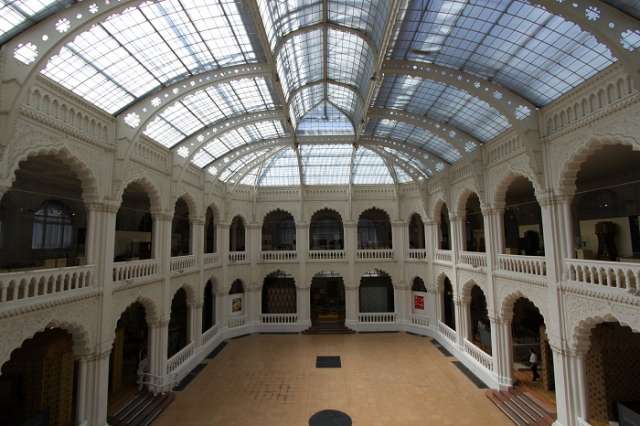
As in other foreign museums the most of works of arts kept in the museums of Budapest are carpets.
Those are the carpets at different periods weaved in the cultural centers of Azerbaijan such as Baki, Guba, Shamakhi, Shusha, Gazakh and Tebriz.
A small carpet of Gazakh referred to the XVIII century and demonstrated in the museum of `Decorative arts` carries particular attention.
Together with ornamental carpets weaved at different times in cultural centers of Azerbaijan you may find here some carpets with original topical composition.
Referred to different periods needleworks of Azerbaijan, kept here as a precious exhibit of the museums are coverings, pillow-cases, table-cloths, saddle-cover and figurative curtains.
As a sample we may show a curtain decorated by the masters of Tebriz in the VXI century.
Works of Azerbaijan art kept at the museums of `Decorative arts` and `The art of the East` of the Budapest do not only embrace carpets and needleworks, those made of metal, wood and pottery as well.
The majority of monuments made of metal are weapons(swords, dagers) and some house equipment (tray, satil, lamp). For artistic and technological peculiarities those samples made of different metals (silver, gold, steel) and referred to the XVIII-XIX remind the style of Shirvan masters. There is only one work made of wood in the museum of Budapest-the figurative rahil (book-supporter) kept in the museum .
The works of Azernaijan art in the United States of America. Most of the works of Azerbaijan masters is kept in America.
In museums, artistic galleries and personal collections in Washington, New-York, Chicago, Los-Angeles, Philadelphia, Huston, San-Francisco, Cleveland, Detroit, Boston and other cities of the USA you may find hundreds of works of national masters.
The most of the patterns kept here are carpets, cloths, figurative metal and pottery.
The most ancient samples among those kept in the USA are metallic works.
It is now kept in the museums `Metropoliten` in New-York, America and `The Art of Asia ` in San-Francisco.
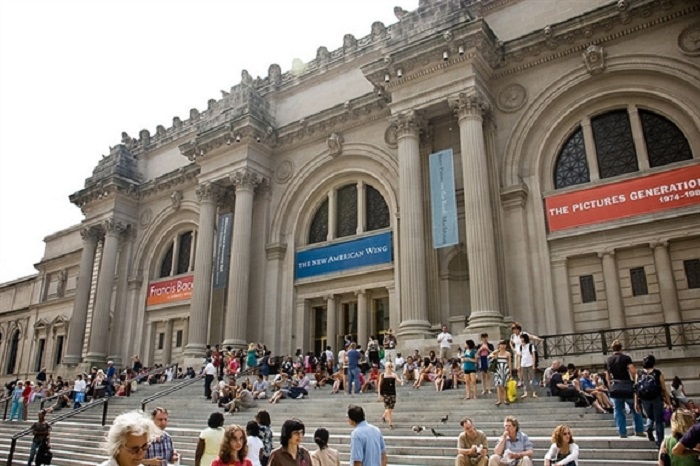
Among the works of metal art kept in the museum `Metropoliten` the most interesting one is referred to the VIII century b.c. accessories found in the province of Ziviya, near the lake Urmiya.
A gold bracelet attracts particular attention of world for its figurative peculiarity and realization.
In the USA one can find plenty of samples of metal art of the middle ages. They are bronze plate of the XII-XIII centuries made in Nakhchivan, kept in the personal collection of Piyerpont Morgan in the USA, bonze plate referred to 703 year according to hijri-gamari(moslem) calendar (year 1304) with the words "Oljayt Khudabende" on it and istirlab kept in the personal collection of Mr. Harari, again decorated with rich ornaments bronze plate of the XII century kept in the museum of art of Cleveland.
Alike in foreign museums, in the shop of ancient things and personal collections you may find many samples of Azerbaijan carpets in the USA as well.
Today this country preserves thousand patterns of ornamental and the best quality fleecy carpets and carpets without pile weaved in major centers of art of our country.
The oldest Azerbaijan carpets demonstrated in the USA are in the museum `Metropoliten` in New-York.
Let us view one of the mentioned carpets.
The great attraction deserves a piece of round velvet with descriptions on it.
The works of Azerbaijan art in the museums of the Great Britain. The Great Britain is one of the countries where you may find ancient works of our folk art.
In the museums located in such the cities of this country as London, Birmingham, Glasgow, Liverpool, Manchester, shops of ancient things and personal collections there are hundreds of works of our art.

From the point of view of figurativeness, the most original works of Azerbaijan masters are now preserved in the museum of Victoria and Albert in London.
The works referred to Azerbaijan are kept in the Near East department of the museum. They are pattens of figurative cloths, needlework, carpets, jewelry, pottery and so on.
Rom the aspect of antiquity the oldest pattern of our folk art kept in the museum of Victoria and Albert is a bronze bowl of 1319.
A particular position among samples preserved in the museum of Victoria and Albert occupy Azerbaijan carpets. For their graphic and technology they are subdivided into Tebriz carpets of the XVI century and the carpets of Guba-Shirvan, Ganja-Gazakh and Karabakh of the XVI-XIX centuries..
In London museum of carpets you may found a carpet weaved in 1892 in Karabakh.
Among the carpets of Tebriz demonstrated in the museum of Victoria and Albert we must especially remind of a carpet known as `Sheyk Sefi` weaved in Tebriz in 1539 by request of Shah Tahmasib for the mosque of Ardebil. XVII-XIX century Azerbaijan carpets preserved at the museum of Victoria and Albert are those once weaved in Guba, Baki, Shamakhi, Gazakh and Karabakh.
In the museum of Victoria and Albert alike other world museums we may find plenty of figurative specimen of cloths referred to the XVI-XVII centuries. There of them are most attractive.
Azerbaijan works of art in France. The majority of now preserved in France specimen of Azerbaijan folk art consist of the works of art weaving. In many museums and personal collection of France you may find hundreds of high quality cloths of Azerbaijan made in Shamakhi, Sheki, Ganja, Nakhchivan and Tebriz. Among them special attention should be paid to topical cloths of the XVI-XVII.
One of topical clothes demonstrated in the museum of decorative arts in Paris draws particular attention.
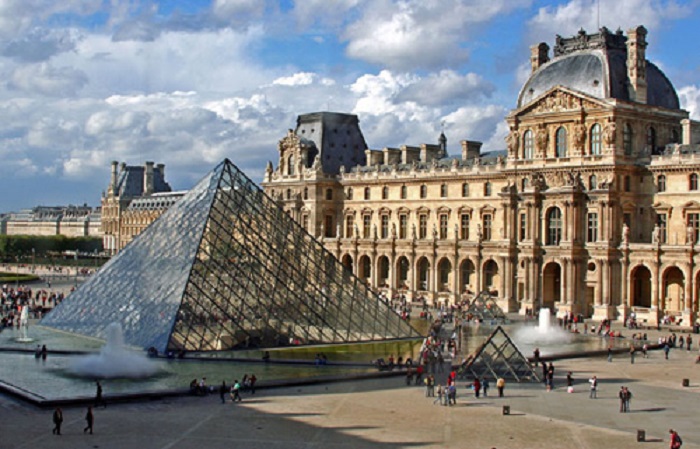
In the museum of Decorative arts in Paris there is an original topical cloth of 26 cm length referred to the XVI century.
Wile peaking about works of art of weaving we should specially mention about carpets demonstrated in rich museums of this country. The most graphically and technologically valuable carpets of Azerbaijan are kept in the museums of Decorative arts and Luvr of Paris.
Let us view one of the carpets demonstrated in the museums of Decorative arts of Paris.
Besides samples of the art of weaving, kept in this cultural center, being one of the richest museums of the world you may also find hundred specimen of art of pottery, glazed tile and graphic metal.
There some rare patterns of metal art made of silver, copper and bronze in Luvr. The most interesting of them is a bronze plate of original figure made in 1190. This specimen is demonstrated under a bell-glass on a high stool in the middle of the East culture hall of the first floor of Luvr.
This bronze plate, in the form a bird with long bill is original not only for its form but, but for its decorations as well. The decorations on the plate are three birds different in size and medallions placed on the spaces between them.
Those decorations made by the technique of forging and scratching are composed of stylized ornamental plant elements and the scripts. One of the scripts reflects the name of the master Osman Salman oglu Nakhchivani.
Azerbaijan works of art in Switzerland. Specimen of our art kept in the museums, personal collections and shops of antique things of the cities Bern, Geneva, Zurich, Basel, Lausanne create a beautiful page of the history of Azerbaijan art.
Many valuable samples of Azerbaijan arts are demonstrated at historical museums of Bern together with material culture of the Europe.
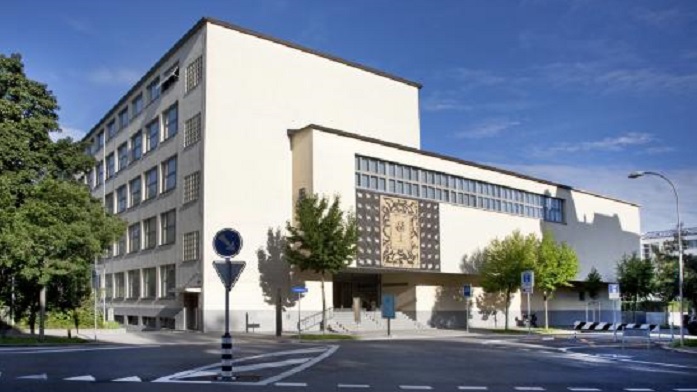
The center of the museum exposition is composed of a great mafrash(a sack to carry linen, carpets, and palazes)stylized in the harmony of blue and red and weaved in the motives of ornaments with kilim (a type of rug) under it. There is a great label near them informing in Germanic that they were weaved in Azerbaijan in the XVIII century. This admirable specimen reminds us the technique of weaving of Karabakh carpets for its figurative and technological peculiarities and is considered to be one of the best exhibits of the department of East art.
An interesting carpet kept in the museum of Bern is `Gollu chichi`, weaved in 1830 in Guba.
Among interesting patterns of Azerbaijan art particular attention is paid to daggers, swords, pistols and gun-powder boxes made in the XVIII-XIX centuries in Shanakhi, Goychay, Ganja, Sheki, Baki, Tebriz, Ardebil. The works made by Shirvan masters prevail in historical museum of Bern.
Among the artistic composition of the weapons kept in the museum we come across with designs of plant and geometry, scenes taken from animal world and also small topical compositions.
Among different kinds of designs of those weapons you may even find scripts written in Arabic language. Those scripts are so skillfully placed among the designs and the descriptions, they look like beautiful design and compose an inseparable part of the general composition. Hose scripts also carry some important historical information. For instance, on decorated by the technique of forging and garasavad nice silver gun-powder box we may read the name of `Shamakhili Seyidzadeh`(inventory # 832), on the a pistol, the butt and the joint of barrel to the body of which are covered with silver decorated pieces we may find the script `amali Ali`(inventory #766), on a small dagger 38,2 cm long with a handle of ivory and the blade decorated with the ornaments you may read "amali Mahammad Ardabili" (inventory # 1178), and on 51,1 cm long dagger with curved blade one may read the names o the master and the owner of the weapon.
On the weapons of Azerbaijan kept in the historical museum of Bern one may find the scripts "Baki", "Guba", "Amali Samed", "Omar"and others.
In the department of East of that museum we may find the patterns of house equipment made of copper widely used by our people in the XVIII-XIX centuries. Those kitchen implements original in form are demonstrated on the text-bench within the niche-frames.
Azerbaijan works of art in Federative Republic of Germany. Only one pattern represents our carpets in Federative Republic of Germany.
Thousands of our carpets are kept In the museums, the shops of ancient things and personal collection found in Bonn, Hamburg, Munich, Cologne, Dusseldorph, Frankfurt-Mayn, Manheim and other cities.
Together with a mass simple carpets one may find in this country rare patterns of carpets weaved at different periods in our motherland.

The originality of Gazakh carpet referred to the XVIII century and demonstrated in 1960 in the shop of the antique things in Munich draws a good deal of attraction on it.
So wide-spread in the world of the East for its constructive structure those designs, seemed like swastika with the tips directed towards four different sides and were such really weaved as if they were circling around one point. The mentioned element of the carpets `Damgali` of Gazakh could also be seen in other kinds of decorative-applied art of Azerbaijan.
Azerbaijan works of art in Turkey. Azerbaijan art patterns as decorative-applied and picturing art examples are generally focused in Istanbul.
The most beautiful and ancient patterns of Azerbaijan art are mainly kept in three large museums in Istanbul. Those are Topgapi palace museum, Turkish and Islam works museum, Carpet museum.
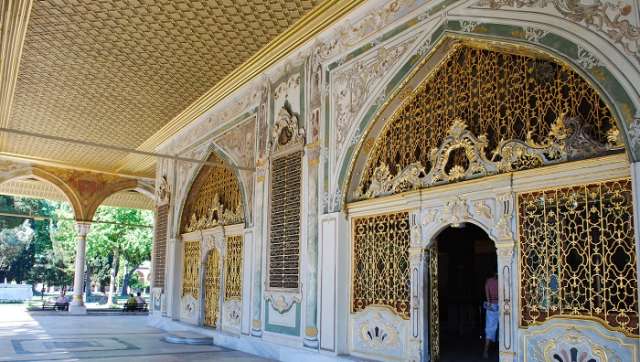
Utensils, jewelry and arms of different metals (gold, silver, steel, copper etc.) exceeded among art patterns, kept in Istanbul museums.
Golden belt, kept in Topgapi palace museum, particularly draws attention among metallic art examples.
Steel hood of 1528, kept in Topgapi, is considered valuable work, giving notion of medieval Azerbaijan jewelry.
Bronze alams (gonfalon), once made in Ardabil and Tabriz, might be included into metal art patterns, kept In Istanbul museums. Bronze alams used to be stuck into roofs of mosques and madrasas (religious school), tops of minarets and had religious essence. Trunks of alams were without adorn as they were stuck into special projections.
The most beautiful part of alams is its top. Religious scripts and symbolical portrayals were given in this part. Alams, kept in Turkish museums at present time, are of two forms: horn and pear-shaped.
You can see figuratively worked out words as Allah, Muhammad, Ali on some of them, and symbolical portrayals on the others.
Some rare patterns of Azerbaijan weaving art are kept in Turkish museums. There are material, fine needleworks and carpets, once made in Shamakhi, Ganja, Sheki, Shusha and Tebriz.
A number of qualitative patterns represent material and fine needlework art of Azerbaijan in Turkish museums at present. Most of them are mainly collected in Topgapi museum, Istanbul. Two examples draw particular attention. One of them is piece of material with plots belonging to XVI century and another is embroidery gown.
Azerbaijan carpets, found world fame are turned to be fine exhibits of Turkish museums.
Azerbaijan carpets are collected in four large museums of Turkey. These are the Turkish and Islam works museum, Topgapi palace museum and Carpet museums in Instanbul, Moylana museum in Koniya.
The most ancient carpet, kept in Turkey, belongs to XVIII century. According to Turkish art critics, this rare pattern of art of weaving, 254 cm length and 170 cm width, was given to Ashraf oglu mosque in Beyshahar as alms. It was brought to Movlana museum in 1932.
We may refer script of difficult painting, exhibiting in the Archeological museum in Izmir, to our original art patterns.
Azerbaijan art patterns in Iran museums. Thousands of rare art patterns, created by Azerbaijan people during centuries, are protected in Iran museums, mosques and private collections at present.
Exhibits of archeological and carpet museums, located in Tehran, Basitan, Gulustan, draw particular attention.
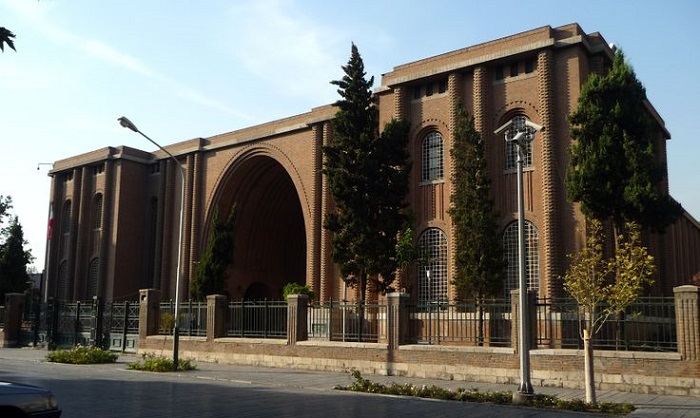
Artistic metallic wares, found in Hasanli hill, has particular significance among our art examples, exhibiting in the Archeological museum in Tehran.
Hasanli hill is situated in Sulduz region, Iranian Azerbaijan. This point with fine nature was one of the richest culture centers of the Near East one thousand year B.C. According to sources, Manna tribe, belonging to Great Midiya state, lived in this territory.
Among art monuments, found in Hasanli hill in 1956-1957 golden bowl, exhibiting in the Tehran Archeological museum, especially draws attention of world scientists.
There are many attractive scenes on the surface of the bowl. Hunter with snack around his head, naked woman laid on two rams, man holding his hand to the wrestler, staying aside, to rescue from tricipalious dragon were described here. These scenes pictured on the middle part of the bowl. An old man was described in the comparatively lower part. A woman, staying before him, holds out an infant. Above that scene a man stands with some plate in his hands with his face to the sandal. There are three more scenes between the description of a hunter with a snake winding around his head.
Referred to the VIII-VII century b. c. gold apron found in the province of Ziviye round the lake Urmiya proves the fact of mutual culture relation exited between Azerbaijan and the neighboring states.
Museums in Iran also keep the carpets made in Azerbaijan. We must particularly mention a carpet weaved in the village Pirabadil of Guba.
More about:
















































